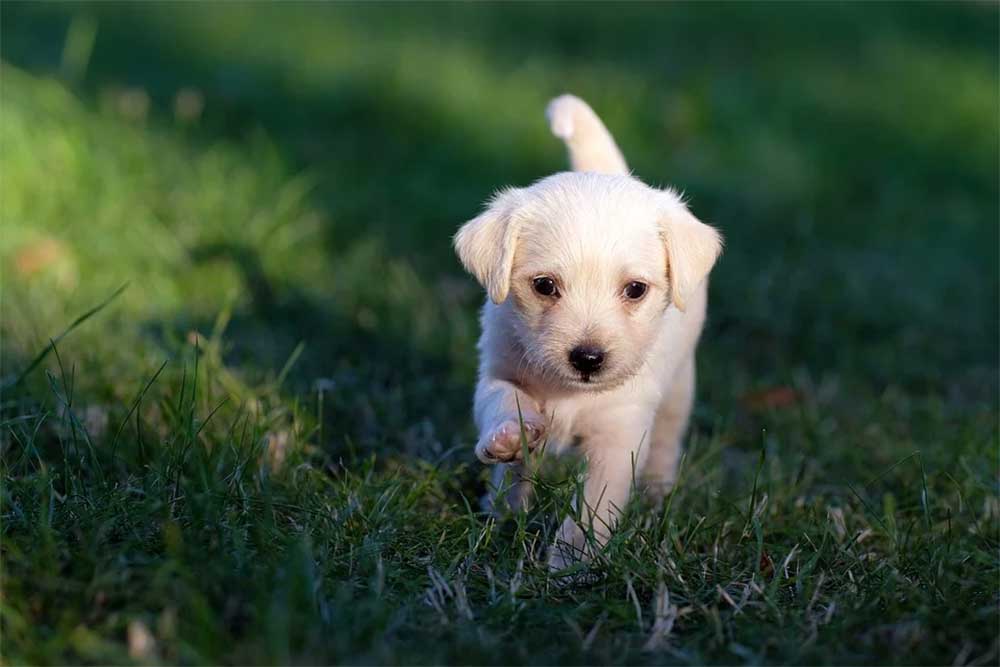Taking care of a newborn puppy can be a scary and uncertain experience. When first adopting or expecting a new puppy, you’ll probably find yourself brimming with burning questions. When do puppies start walking after birth? When do puppies start walking properly? When can I take my puppy outside? And a whole trove of other questions that you fear will never be answered.
But there’s nothing to worry about, for we have the answers to all your puppy-related questions. Down below, we have compiled a guide that will take you through the puppy walking process. Covering everything from their shaky early days to being walked properly on a leash. By following this information, you will be able to track your puppy’s development. While also answering those lingering questions that may be setting your nerves on edge.

So, when do puppies start walking after birth? If you want a quick answer, then here it is. Newborn puppies should begin walking when they are 4 weeks old. However, the walking itself will be shaky and unsteady. Before a puppy can walk properly, it needs to learn how to balance itself. This process can take a further 4-7 weeks and will result in the puppy walking with strong and steady steps.
But if you want a more detailed discussion of the walking process, then keep reading because there’s a lot more information that you need to know.
When Do Puppies Begin Walking After Birth?
When caring for a newborn puppy, you are essentially taking care of a baby in the earliest stages of its development. This means that the puppy is still learning and growing, and this process can take some time. However, puppies usually begin to mature once they have opened their eyes for the first time. This will normally happen up to two weeks after their birth.
At two weeks old, the puppy will begin to waddle around the room. Let them do this! Although it may not look comfortable for the puppy, it is essential in helping them to build and strengthen their growing leg muscles. It is around this time that the puppy will also begin to stand. Although its first few attempts will be unsteady and shaky, this will allow the puppy to grow stronger and more confident using its legs for movement.
Once the puppy is three weeks old, it will begin wanting to explore the world beyond its litter. This will be exhibited when the puppy begins climbing out of its whelping box, or even by climbing over its own mother for sport and entertainment. If you are concerned about the puppies beginning to move more freely, then you can invest in a large playpen to give them space in which to crawl and develop.
When your puppy is four weeks old, they will be able to walk short distances and with wobbly steps. This will eventually develop into a more confident stride as the puppy gets older and stronger. If your puppy is still not capable of walking at 4 weeks old, then you should consider taking them to a veterinarian for a professional diagnosis.
When Do Puppies Begin Walking Properly?
After reaching the four-week milestone, your puppy will continue to develop and grow. However, the process will now move at a more rapid and noticeable pace. During this time, the puppy will continue to build their leg muscles and confidence, resulting in a more balanced and steady gait. This process will continue until they are seven to eight weeks old, then your puppy should be fully active.
Once your puppy is eight weeks old, you can start taking them for short walks around your home or garden. General exercise can be extremely beneficial for the puppy’s development, as it will keep them active and prepare them for longer walks when they are older. However, you must remember that even at two months old, a puppy is still a small and fragile thing. Too much exercise could prove damaging to their bones and joints, which remain fragile until they are two years old.
What Can Be Done To Help?
Seeing your puppy trying to crawl or stand for the first time can be a joyful (and worrying) experience. And in some cases, it may feel like there’s nothing you can do to help them in their progress. Of course, there’s nothing you can do that will speed the process along. These things will always take time and you have to remember that the puppy is moving at its own natural pace. So do not try and force them because that won’t help them or you in the grand scheme of things.
However, there are some things that can be done to help your puppy in their development. These things are simple and will make the whole process a little more comfortable for your little baby dog. For example, when the puppy is still only learning to stand, you should not be placing them on a slippery surface. This will make standing up, and even walking, very difficult for the puppy when they are still shaky using their legs. To avoid this, make sure the puppy has plenty of blankets or even a rug when learning to stand or walk. This will cause some much-needed traction during the development period.
Rugs can also be beneficial for your puppy when they are beginning to walk and explore the house. Always make sure that the puppy has rugs on the floor, as this will provide them with some good grip when they want to search their surroundings.
When Do Puppies Begin Walking On A Leash?
You can actually introduce your puppy to the leash when they are 8 weeks old. However, we do not advise taking them to the park until they have been fully vaccinated.
When introducing your puppy to the leash, you have to understand that the process can take a long time. Puppies have never seen a leash before, and they won’t understand why you’re putting one on them. However, if you’re patient then you will be able to help them adapt to the leash as time goes by.
We suggest training a puppy that is between eight to ten weeks old. To begin the training process, it is advisable to put the collar on the puppy while they walk around the house. This will allow them to adapt to the feel and weight of the collar. It will also help them find their balance while wearing the harness, assuring that it does not affect their gait. Make sure to only do this for short periods of time throughout the day.
When making your puppy wear a collar indoors, it is important to help associate the harness with fun and positive vibes. For example, after you’ve put the leash on your puppy, you can reward them with a treat. By doing this, the puppy will begin to recognize wearing the collar as an activity that gets them rewarded. This will help to build their enthusiasm and interest in the collar, which can be very beneficial for the future.
It is also important to create a vocal cue for the leash that will let the dog know when you want to put it on them. Make this a pivotal part of the training process; if you cue the dog and they allow you to put the leash on them, then reward them for their good behavior. Again this will help the dog associate the leash with positive reinforcement. The vocal cue itself can be anything from a simple whistle to a gentle “here boy” As long as the puppy responds then it doesn’t matter.
When the puppy is comfortable in the harness and capable of being walked around the house while wearing it, then they are ready for outdoor walking. However, when first taking your puppy out for a walk, we advise maintaining the trips only to the backyard. The puppy may be over-excited due to the sudden exposure to new scents and sounds. Use the time in the garden to get them used to the outdoors, assuring you use your vocal cue and rewarding them when they do a good job.
Do Not Do This When Walking Your Puppy

When first taking your puppy for a walk around the garden or even to a local park, it can be difficult making sure they behave. Puppies will get excited when introduced to the great outdoors, and this can sometimes lead to excitable or strange behavior. And we understand that this can be trying for you as the puppy’s owner. However, regardless of how much the puppy acts up, you should never perform the following techniques to correct their behavior.
- Do Not Pull The Leash
During your first time taking your puppy for a walk (even if it’s only in the garden), they may be greatly distracted by their new surroundings. So if they pause in their progress, or become unresponsive, you should never try pulling the leash to get their attention. This could hurt the puppy and make them associate the collar with pain, which wouldn’t be helpful to either of you. Instead of yanking the collar, stand completely still and let the puppy return to you in their own time. This will help them to realize that without you they can’t really go anywhere.
- Do Not Overexert Your Puppy
Although you may be excited to take your puppy outdoors for the first time, you have to understand that puppies are still basically babies and they are not capable of vast amounts of walking. For a puppy who is three to four months old, it is advised to walk them for about fifteen to thirty minutes every day. Over-exercising your puppy could greatly damage their health, making them more prone to injuries and aches. You can start running or jogging with a dog when they are twelve to eighteen months old.
- Do Not Let Your Puppy Lunge
As we have previously mentioned, puppies can get pretty excitable on their first walks and this can cause some problems if their behaviour isn’t kept in check. For example, the more energetic puppy may be prone to lunging at other dogs and people. Although this can be harmless, it isn’t advised to encourage such behaviour from your dog. Lunging can lead to injury and even violent encounters with other dogs who mistake the lunge for an attack. To prevent your dog from lunging, you should try to implement some basic distraction techniques.
Taking your puppy for a walk is meant to be a fun and bonding activity, so always make sure that you are patient and caring whenever they make a mistake or become overly excitable because using negative techniques to hold your dog’s attention could greatly affect their well being and your relationship.
When Can Puppies Begin Walking In Dog Parks?
When your puppy has started walking, and you’ve taken them for walks in the backyard, then you may think that they are ready to go to a local dog park. However, this might not exactly be the case when you consider some important factors.
For example, is your puppy fully vaccinated? Dog parks can be wonderful places for puppies, where they’re allowed to meet other dogs and run around to their heart’s content. However, this does not mean that dog parks are completely free from risk.
After all, you will be exposing your puppy to other (possibly unvaccinated) dogs who could give them a fatal illness or disease. Before even considering taking your puppy to the dog park, you have to make sure that they have received all the necessary vaccinations.
Very young puppies will not be fully vaccinated until they are four months old, so you must wait until they have had all their shots before exposing them to other dogs and bacteria. However, once they have been vaccinated you can take them to the dog park as much as you want.
